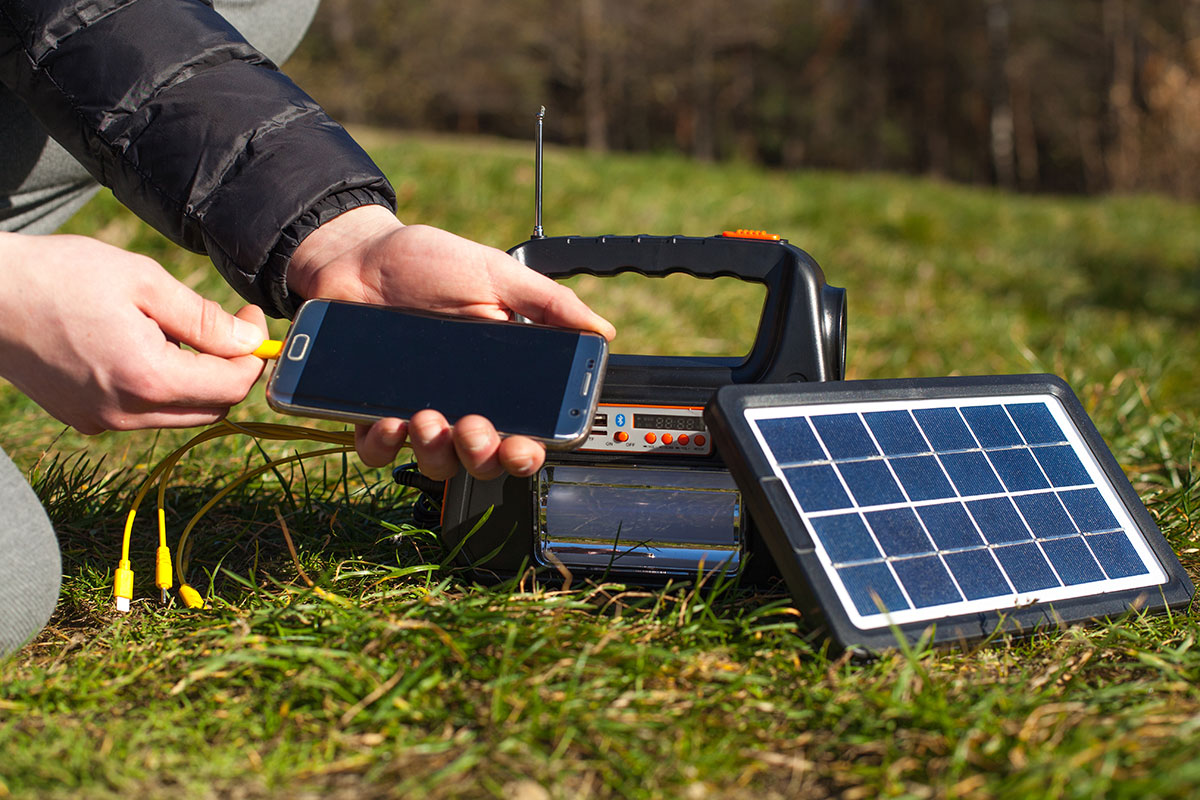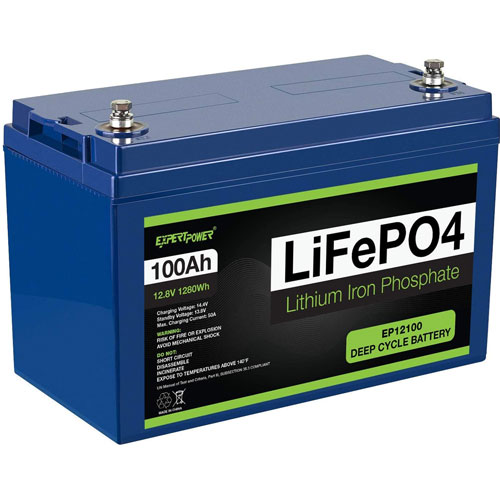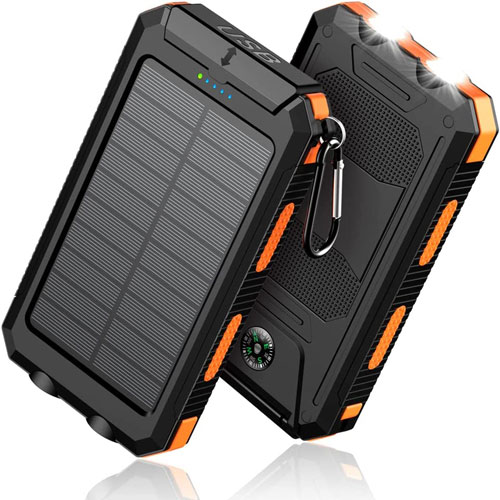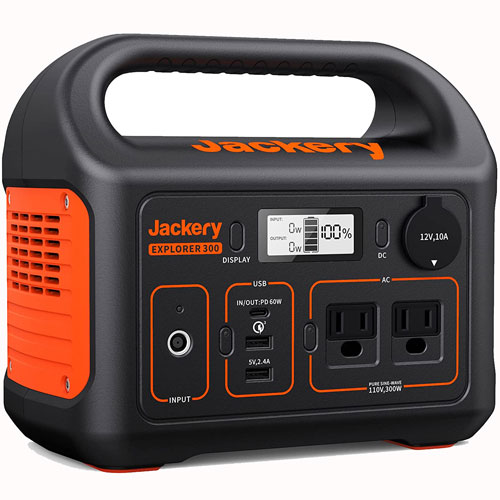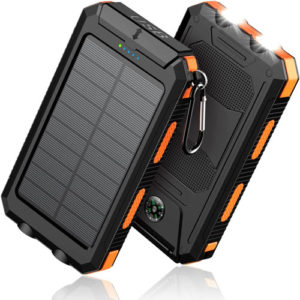If you buy through affiliate links, we may earn commissions, which help support our product reviews.
Last Updated: Jan 5, 2024
As avid campers, we all know the drill. You’re out in the wilderness, the stars are shining, but oh no – your phone’s dead, and you wanted to snap some pictures of the night sky. Or maybe you’re trying to catch a football game by the campfire, but your device is running low on juice.
That’s where a reliable power source comes in handy. But remember, staying powered is just one part of staying safe outdoors. Check out our guide on personal locator beacons for that extra layer of safety.
Now, let me share with you a few top picks for batteries and portable chargers that will keep your devices up and running during your outdoor adventures.
Powerhouse Trio: The Top Three Batteries for Your Camping Adventure
For the RV Enthusiasts: ExpertPower LiFePO4 Deep Cycle Battery
If you are in the market for a 12v battery for RV or Drycamping use that will last, this is the one to get. ExpertPower’s LiFePO4 Deep Cycle Lithium-Ion Battery offers an impressive 2500-7000 cycles and a 10-year lifetime – much longer than typical lead acid batteries with only 200-500 cycles and a 3-year lifetime.
It also has an efficient power output, holding over 12V for up to 95% of its capacity! Many smaller sizes are available.
Solar Enthusiasts, Rejoice: Feeke Solar Charger Power Bank
This amazing power bank is perfect for camping. It has a 36800mAh large cell capacity, making it one of the highest-capacity solar chargers on the market today. The sun-powered design means you won’t have to worry about plugging it in to charge. Plus, it uses industry-leading high-density lithium polymer cells, making it more compact and more considerable in capacity than other power banks.
For a Lot More Juice: Jackery Explorer 300 Portable Power Station
The Jackery Explorer 300 is the perfect choice for those who need a reliable power source while on the go. It features two 110V/300W pure sine wave AC outlets, making it compatible with even the most sensitive electronics. Plus, its 293Wh lithium-ion battery provides enough juice to simultaneously charge up to 6 devices. And you can recharge it in as little as two hours with a wall outlet and a USB-C port. The solar panel charger is sold separately.
Choosing the Right Battery for Your Camping Style
The best type of battery for you all depends on your camping setup. If you’re camping with a camper or RV, you will want to look into deep-cycle, 12-volt, high-amp-hour AGM or Lithium-Ion batteries. These are typically more reliable and have a longer lifespan than standard lead acid batteries.
If you don’t have a camper, you will want to keep a battery pack or a portable power station with you. This way, you can take the unit into your tent and charge up your electronics while you sleep. No more worrying about dead phones during camping trips!
Key Factors to Consider
When looking for a battery to take camping, there are a couple of things you should watch for. Here are five of the most important:
Capacity
How much electrical energy can your battery store? Look for a battery with higher ampere-hour (Ah) or milliampere-hour (mAh) ratings for longer run times on your electronics. Ampere-hours is the amount of energy charged that enables 1 ampere to flow for 1 hour. 1 Milliampere hour is 1,000th of 1 Ah.
Lifecycle
What is the battery’s cycle life? How many times can you recharge it before it begins to lose performance? Lithium-Ion batteries typically have a higher cycle life than lead-acid batteries. This, of course, is significantly affected by the rate of discharge.
Ports
What types of ports does your battery feature? It’s crucial to ensure that the battery you choose includes the ports you need for charging your electronics. Most batteries feature USB, micro USB, and lightning ports. Some power stations even offer 110v household plugs for plugging in larger items like laptops.
Size and Weight
How light and compact is the battery you’re looking for? Battery packs and power stations come in various sizes, so it’s essential to ensure the one you choose is of the size and weight you are good with. The larger batteries can hold more charge and are often better for longer camping trips.
Price
Finally, what is your budget? Battery prices vary greatly and depend on the type of battery, capacity, brand, and more. Look for a battery that is within your price range but still offers the needed features.
No matter what type of camping you are doing, having a reliable power source is essential. With the right battery, you can stay connected and enjoy your time outdoors without worries!
Trail-Tested and Proven: Our Top 7 Picks for Camping Batteries
ExpertPower 100Ah LiFePO4 Review
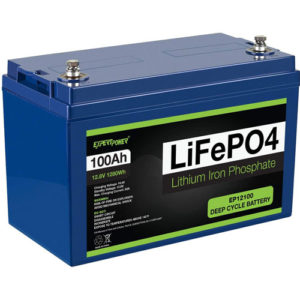 Power Rating: 12V 100Ah (1280Wh)
Power Rating: 12V 100Ah (1280Wh)
Battery Type: LiFePO4
Max Discharge Current: 100A 2Sec.
Built-in BMS: Yes
Weight: 22.6 lbs
Dimensions: 13 x 6.8 x 8.4
Setup & Install Experience:
The ExpertPower LiFePO4 Deep Cycle Battery is an excellent option for camping. It has an impressive max continuous discharge rate of 100A and a peak discharge rate of 200A @ 2sec. This battery also comes with a built-in BMS, which helps to protect it from overcharging, over-discharging, short-circuiting, and even high temperatures. It also comes with M8 terminal screws for easy wiring and installation.
Pros
- High Capacity
- Up to 7000 cycles (50% DoD) and ten year lifetime
- Maintenance free
- 1 Year warranty
- Built-in Battery Management System
Cons
- Heavy – Not very portable
Performance & Overall Experience:
The ExpertPower LiFePO4 Deep Cycle Battery is a great all-around battery for camping applications. It has excellent performance and capacity, perfect for powering your RV in the wilderness. We found that it was easy to install, with the M8 terminal screws and built-in battery management system.
The battery also has a great life cycle, up to 7000 cycles and ten year lifetime! We also tested this battery in cold climates and found it functioned fine when its temperature was -4°F and up. However, as with all lithium batteries, it needed at least 32+ °F to charge correctly.
Tested Features:
- Charging 14.2V ~ 14.6V at 32°F
- Several cycles on a 28-foot motorhome
- Resting Voltage: 12.81V
- Cut-off voltage: 10.88V
- Inverter compatible
Technical Details:
| Dimensions | 13 x 6.8 x 8.4 inches |
| Weight | 22.6 lbs |
| Model number | EP12100 |
| Batteries | 1 x LiFePO4 Battery |
Blavor Solar Charger Power Bank Review
Power Rating: 10000mAh
Battery Type: Lithium Polymer
Max Output: 2.4A
Weight: 9.2 ounces
Dimensions: 5.51 x 3.07 x 0.79 inches
Setup & Install Experience:
The Blavor Solar Charger Power Bank is a great option when you need an emergency power bank on the go. This power bank can be charged with USB C or solar energy, making it perfect for outdoor activities such as camping, biking, and hiking. It has two 5V/2.4A fast-charge USB outputs and a high-precision compass for accurate navigation.
The power bank also has a super bright flashlight with an effective distance of 80 meters and can last up to 100 hours! It is also shockproof, dustproof, and waterproof, making it an excellent choice for outdoor use.
Pros
- Dual USB fast charge
- High precision compass
- Super bright flashlight
- Waterproof, Shockproof, and Dustproof
- Solar Charge Power Bank
Cons
- Not waterproof when charging
Performance & Overall Experience:
The Blavor Solar Charger Power Bank is an excellent choice for powering your devices while on the go. It charges very quickly with its dual 5V, 3A fast-charge USB outputs and can also be charged with solar energy.
We found that compared to other power banks, it was great to have a bright flashlight when we fumbled outside the tent at night. We also found these power banks to be waterproof and shockproof enough for our uses, making them excellent power banks for outdoor use in all elements.
We did find that the power bank is NOT waterproof when charging, so take care not to expose it to water while charging. All in all, this is a top choice for anyone looking for an emergency charger with solar capabilities!
Tested Features:
- Dual USB fast charge
- Solar Charge
- High precision compass
- Flashlight
- Waterproofness, Shockproofness
Technical Details:
| Dimensions | 13 x 6.8 x 8.4 inches |
| Weight | 9.2 0z |
| Power Rating | 10000 mAh |
| Battery Type | Lithium Battery |
Jackery Portable Power Station Explorer 300 Review
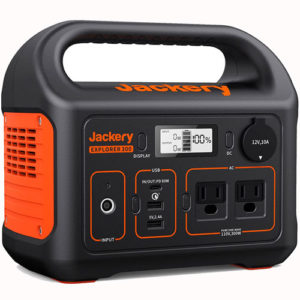
Power Rating: 293 Wh (20.4 Ah, 14.4V)
Battery Type: Lithium Batteries
AC Output: 110V, 300W (500W peak)
Quick Charge 3.0 Output: 5~6.5V 3A
USB-C Port: 5V 3A, 9V 3A input/output
USB-A Port: 5V 2.4A
Setup & Install Experience:
The Jackery Portable Power Station Explorer 300 is great for camping, tailgating, and other outdoor activities. It has two 110V/300W Pure Sine Wave AC outlets and can be charged by AC adapter, car charging, or solar charging capable (solar panel not included).
It’s also lightweight at only 7.1 lbs and takes only 2 hours to charge up to 80%. We found the installation process simple, with everything you need included in the package.
Pros
- Lightweight & portable
- Fast charging
- Multiple AC & USB ports
- Great customer service
Cons
- Cannot power heavy loads
Performance & Overall Experience:
We took the Jackery Portable Power Station Explorer 300 with us on a camping trip and tested its performance under various conditions. We found it lasted all weekend when used with light loads, power for our laptops, recharging phones, running a few lights, etc., and we could charge several devices multiple times without any issues. How it fared with heavy loads was a different story, however. We could power minor appliances such as a fan or laptop, but powering heavier items such as a coffee machine was impossible.
The Jackery Portable Power Station Explorer 300 is an excellent option for lightweight and portable power. How it fares with heavy loads might be a letdown for some, but considering its portability and fast charging time, this power station would make an excellent companion on your next outdoor adventure.
Tested Features:
- Portability & Weight
- Durability
- Charging Time
- AC & USB Ports
- Performance under Light Loads & Heavy Loads
Technical Details:
| Dimensions | 9.1″L x 5.2″W x 7.8″H |
| Weight | 7.1 lbs |
| Power Rating | 293Wh |
| Battery Type | Lithium Batteries |
LIPOWER 300W Portable Power Station Review
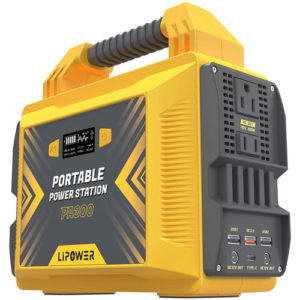
Power Rating: 296 Wh
Rated Power: 300W (Peak 500W)
AV Output: 110V/60Hz
USB Output: 5v/2.4A Max
Type-C Output: 18W
Weight: 6.38 pounds
Dimensions: 10 x 4.7 x 9.1 inches
Setup & Install Experience:
The LIPOWER 300W Portable Power Station was easy to set up and use. We just had to plug in the AC adapter and charge it. It takes only 4 to 5 hours to charge fully, and you can also use a car charger or solar panel (not included) to power it up. Weighing in at only 6 pounds, the power station is lightweight and can easily fit into a backpack or suitcase. (Solar Panels not included)
Pros
- Lightweight & portable
- Quick charging time
- Multiple AC & USB ports
- Large Battery Capacity
- 18 Month Warranty
Cons
- Limited charging ports
Performance & Overall Experience:
We took the LIPOWER 300W Portable Power Station on a camping trip in the North Maine Woods, and it passed all of our tests. The two 110V/60Hz AC outlets could power a few small appliances, and we could charge our phones, tablets, cameras, and laptops multiple times on a single charge. We tested the USB and Type-C ports, which both worked great, and we were able to charge multiple devices simultaneously without any issues.
Overall, the LIPOWER 300W Portable Power Station is an excellent choice for outdoor activities. It’s lightweight, has ample battery capacity, and offers fast charging time. We recommend it for all your camping trips and outdoor adventures. Even better, if you pair it with a great 100W Portable Solar Panel for unlimited outdoor charging.
Tested Features:
- Portability & Weight
- Durability
- Charging time with solar panels: 4-5 hours
- AC/DC & USB Ports
- Performance under Light Loads & Heavy Loads
Technical Details:
| Dimensions | 10 x 4.7 x 9.1 inches |
| Weight | 6.38 lbs |
| Part Number | PA300 |
| Battery Type | Lithium Battery |
Fokimdo Solar Power Bank Review
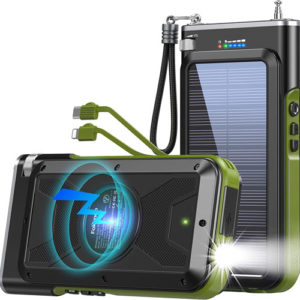
Power Rating: 36800mAh
Battery Type: Lithium polymer
Weight: 1.17 lbs
Dimensions: 1 x 1 x 1 inches
Rated Power Output: 15W/5V/3A Fast Charging
Inputs: USB Type-C, Micro USB, Solar
Check Price
Setup & Install Experience:
The Fokimdo Solar Power Bank was straightforward to set up and use. We plugged it in with the included USB-C cable, and after a few hours of charging, we were ready to go. The power bank also has two LED indicators that show how much power is left, so you can quickly check the battery level.
Pros
- Lightweight & portable
- Fast charging time
- Multiple input options
- Large battery capacity with dual USB ports
- Attached Solar Panel
Cons
- No AC/DC output option
Performance & Overall Experience:
We tested the Fokimdo Solar Power Bank on a Friday night campout with the kids. We could charge our phones and other gadgets with the dual USB ports. We could also use the attached solar panel to keep it at 100% throughout the day. The power bank held up well and was surprisingly lightweight, making it easy to carry around.
The Fokimdo Solar Power Bank is excellent for camping and outdoor adventures. It’s lightweight, has a large battery capacity, and offers multiple input options. We recommend it to anyone looking for one of the best portable power packs to keep their phones charged on a camping trip.
Tested Features:
- Emergency Radio
- Portability & Weight
- LED Flashlight
- Charging time with solar panels
- Inputs: USB Type-C, Micro USB
- Performance under Light Loads
Technical Details:
| Dimensions | 1 x 1 x 1 inches |
| Weight | 1.17 lbs |
| Model Number | PN-W26 |
| Battery Type | Lithium polymer (included) |
Renogy Deep Cycle AGM 12 Volt 100Ah Battery Review
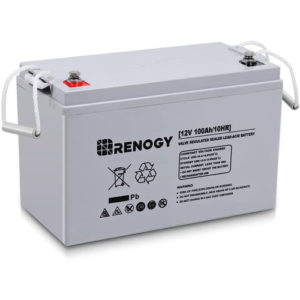
Power Rating: 12V 100Ah
Battery Type: Lead-acid, AGM
Max Discharge Current: 1100A 5 sec
Built-in BMS: No
Weight: 66 lbs
Dimensions: 13 x 6.8 x 9 inches
Setup & Install Experience:
The Renogy Deep Cycle AGM 12 Volt 100Ah Battery was surprisingly easy to install. We connected the battery terminals to our RV’s electrical system and were ready to go. The included instructions gave us a step-by-step guide on how to set up the battery correctly, which was very helpful.
Pros
- 2-year material and workmanship warranty
- No acid leakage, no water refilling
- Outstanding discharge performance
- Longer shelf life
Cons
- Heavyweight & bulky
Performance & Overall Experience:
We tested the Renogy Deep Cycle AGM 12 Volt 100Ah Battery during a two-week RV trip and were very impressed with its performance. It provided enough power for all our appliances, lights, and electronic devices without any issues. We also liked that it didn’t require any maintenance or refilling of water.
Overall, the Renogy Deep Cycle AGM 12 Volt 100Ah Battery is an excellent choice for RV owners. It can provide reliable power for your appliances and electronic devices with its long-lasting charge. The 2-year material and workmanship warranty also provides peace of mind, so you can be sure it will last a long time. We were able to charge it while driving
Tested Features:
- Charging Capacity & Time
- Charging 14.2V ~ 14.6V at 32°F
- Several cycles in our 28′ motorhome
- Resting Voltage: 12.81V
- Cut-off voltage: 10.88V
- Inverter compatible
Technical Details:
| Dimensions | 13 x 6.8 x 9 inches |
| Weight | 66 pounds |
| Model Number | B075RFXHYK |
| Battery Type | 1x 12 Volt AGM Battery |
Anker Portable Battery Pack Review
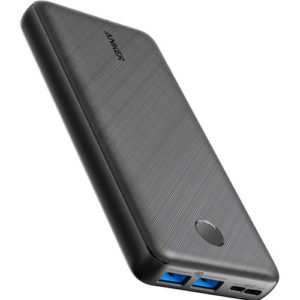
Battery Power: 20,000mAh
Battery Type: Lithium battery
Inputs: USB Type-C, Micro USB
Outputs: Dual USB ports
Weight: 12.1 ounces
Dimensions: 6.22 x 2.93 x 0.76 inches
Setup & Install Experience:
The Anker Portable Battery Pack is surprisingly easy to set up and use. We plugged in the Micro USB cable, and it was ready. The battery pack also has a convenient LED indicator to check the battery level easily.
Pros
- Lightweight & portable
- Fast charging time
- Multiple input options
- Large battery capacity
Cons
- No wireless charging
Performance & Overall Experience:
We tested the Anker Portable Battery Pack during a day trip up Mount Katahdin, and it worked perfectly. It could charge our phones and other gadgets with dual USB ports. The capacity was also large enough to keep four of our phones charged up all day.
We recommend the Anker Portable Battery Pack for camping trips and other outdoor activities over other portable power packs for a few reasons. It’s lightweight, has a large battery capacity, and offers two USB inputs. We found it an excellent choice for keeping all your gadgets charged while also enjoying nature!
Tested Features:
- Charging Capacity & Time
- Charge test with iPhone 12, iPhone 11, iPad Pro, and Samsung Galaxy S21
- Charging from 0 to 100% in 1.5 hours
- Battery Level Status Indicator
Technical Details:
| Dimensions | 6.22 x 2.93 x 0.76 inches |
| Weight | 12.1 ounces |
| Model Number | A1271H21 |
| Battery Type | Lithium battery |
*Bonus* Best Solar Panels For Camping
Jackery SolarSaga 100W Portable Solar Panel Review
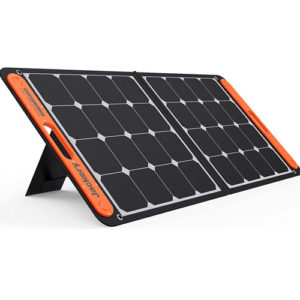
Peak Power: 100W
Power Voltage: 18V
Power Current: 5.55A
USB-A Output: 5V-2.4A
USB-C Output: 5V-3A
Weight: 6 lbs
Dimensions: 22.83 x 19.69 x 2.36 inches
Setup & Install Experience:
The setup and installation experience of the Jackery SolarSaga 100W solar panels were remarkably straightforward, making it an excellent choice for those just starting with solar energy. The solar panel is surprisingly lightweight, weighing only 6 pounds, and its plastic construction ensures it’s durable enough to withstand inclement weather. With dimensions of 1220 x 535 x 5mm when unfolded and 610 x 535 x 35mm when folded, these solar panels are relatively compact and easy to transport around.
Pros
- Easy to use
- Affordable
- Portable
- Durable
- Convenient
Cons
- Some customers reported faulty units on delivery
Performance & Overall Experience:
The Jackery SolarSaga 100 performed very well and surpassed my expectations while camping at the beach. I could keep my phone and laptop charged for the entire trip using just one panel connected to the Jackery Explorer 300 Power Station, which made for a much more relaxing experience.
The only downside was that it took up quite a bit of space in my backpack, but that’s a small price to pay for being able to stay connected even while roughing it. My experience with the product has been overwhelmingly positive, with no significant complaints or issues.
Tested Features:
- Charging Speed
- Charge test with Jackery Explorer 300 Power Station
- Charging from 0 to 100% in 4 hours
- WaterProof-ness
Technical Details:
| Dimensions | 22.83 x 19.69 x 2.36 inches |
| Weight | 6 pounds |
| Model Number | SolarSaga 100 |
| Max Power | 100 Watts |
How To Use And Care For Your Battery While Camping
When camping, it is essential to use and care for your battery correctly to ensure its longevity and performance. Here are ten valuable tips to help you get the most out of your portable battery when hitting the trails:
- Always check if the amperage rate is within the voltage range before attaching any devices.
- Keep your battery away from direct sunlight when not in use.
- Avoid water or moisture exposure, even while cleaning.
- Do regular internal inspections and give it a light cleaning every few weeks.
- Connect compatible devices to avoid overloading or damaging either.
- Use an appropriate charger that matches its current capacity rating at all times.
- Run a test after the initial setup.
- Never charge batteries past maximum capacity (use LED indicators as reference).
- Please don’t leave them plugged in when not used; this will preserve their lifespan the longest.
- Take some time each season for preventative care and maintenance of your battery pack.
Following these steps ensures reliable performance for many camping trips to come!
Our Camping Battery Champion
The Jackery Explorer 300 is the best power source for camping. It performed exceptionally well while charging our gadgets, and its portability made it easy to take with us on our trips.
We also appreciate that it is affordable and has several helpful features, such as the water-resistant design and multiple charging ports. Overall, we highly recommend this battery power station for anyone who loves to camp and wants to stay connected even while enjoying nature!
Frequently Asked Questions About Camping Batteries
What Makes a Good Camping Battery?
A good camping battery should have a high capacity, measured in ampere-hours (Ah), to ensure longevity. It should also be durable, lightweight, and portable for easy transportation. Look for batteries with various output ports for charging different devices and consider the lifecycle, indicating how many charge cycles the battery can handle before its performance declines.
Can I Use a Regular Car Battery for Camping?
It’s not recommended to use a regular car battery for camping. Car batteries are designed for short, high-power bursts to start an engine, not for prolonged discharging. Instead, opt for a deep-cycle battery, which is designed for sustained energy output and can be discharged and recharged repeatedly without damage.
How Do I Keep My Battery Charged While Camping?
To keep your battery charged while camping, consider solar chargers if you’re in a sunny location. Solar panels can recharge your battery during the day. Alternatively, you can use a car charger if you’re near your vehicle, or choose batteries that have high energy efficiency and longer life cycles to reduce the frequency of recharges.
